This page and the linked pages contain documents and information about the ancestors of Albert Herz.
Because of complicated nature of the earlier ancestors of Albert Herz, this page only goes as far back as his grandparents. A complete discussion will appear in the chapter "Common Ancestors" in the third book of the series on our ancestors.
This graph
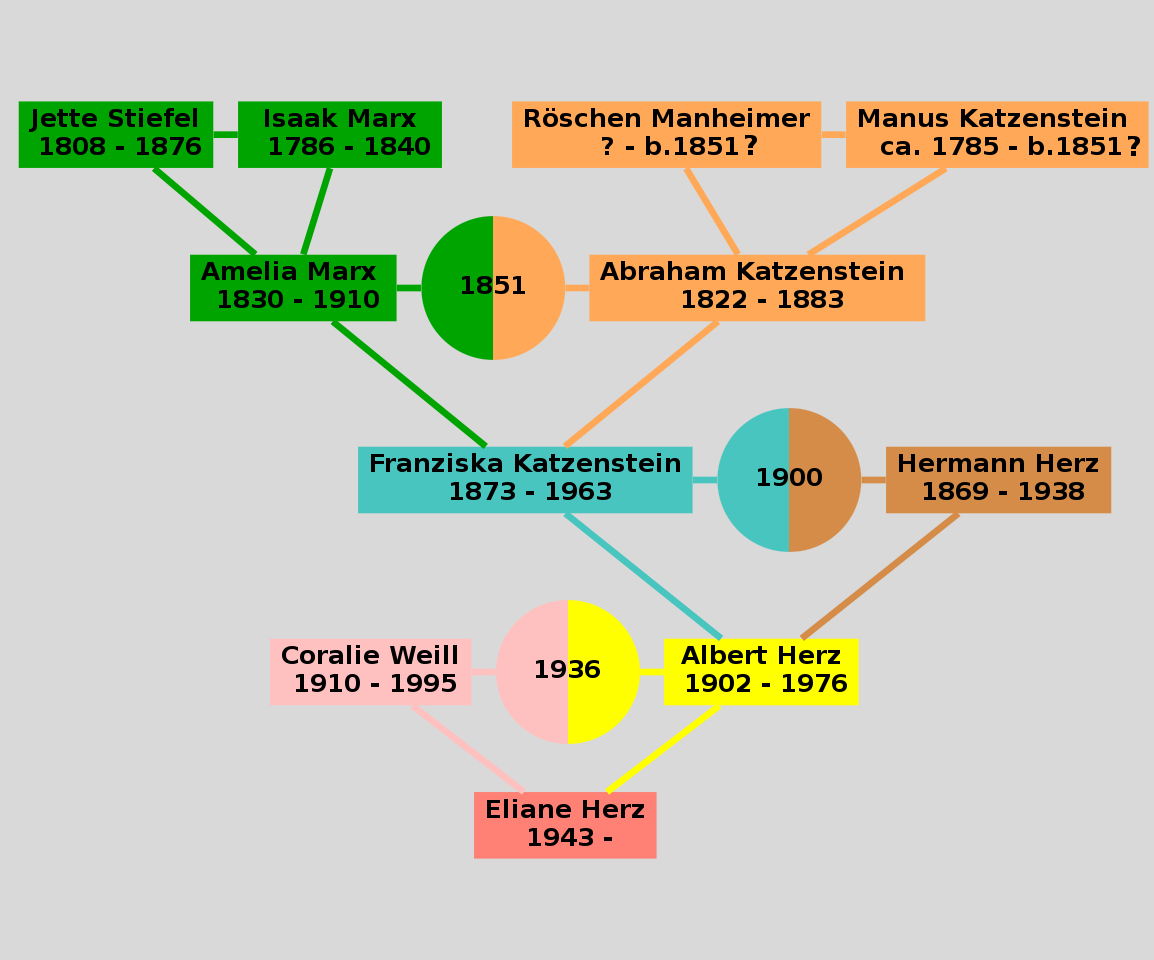 shows Albert Herz's parents and then back to the grandparents of his mother.
shows Albert Herz's parents and then back to the grandparents of his mother.
This graph
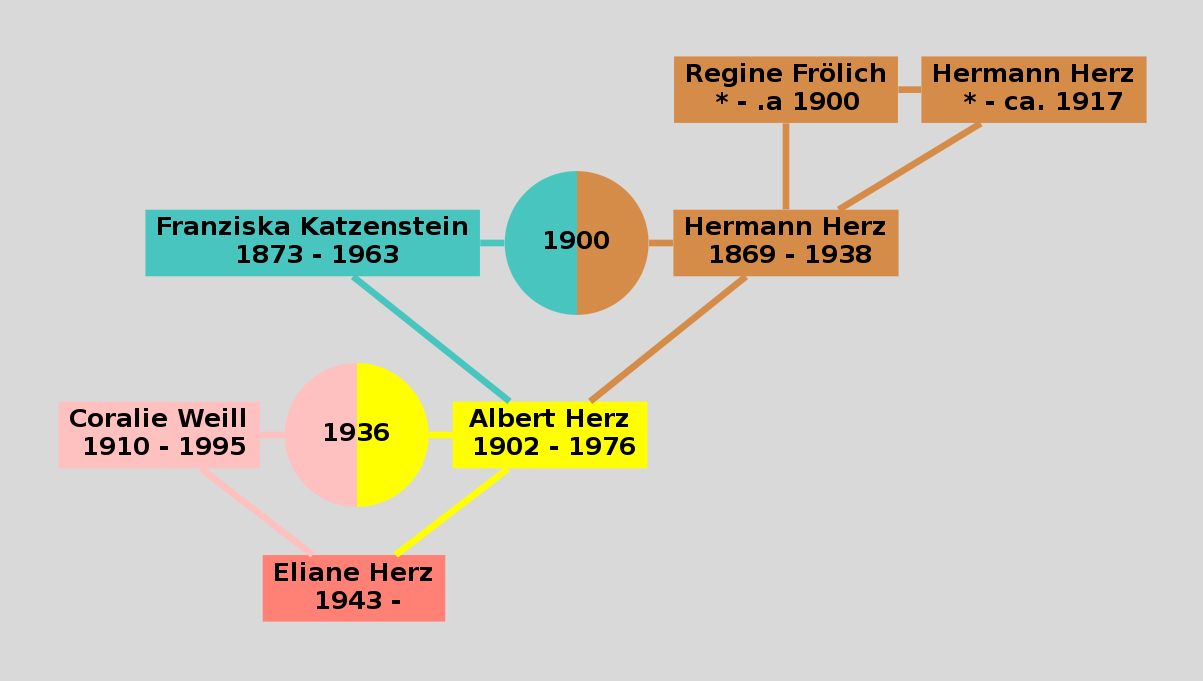 shows Albert Herz's parents and the parents of his father.
shows Albert Herz's parents and the parents of his father.
This graph
 shows how Eliane and Roger are related via two daughters of Amelia Marx and Abraham
Katzenstein.
shows how Eliane and Roger are related via two daughters of Amelia Marx and Abraham
Katzenstein.
The numbering system for ancestors is described in the book An Alsatian Jewish Story / The
Ancestors of Coralie Weill of Marmoutier.
Franziska Katzenstein (1869-1963) and Herman Herz (1869-1938)
-
Here is the original birth registration
 of Franziska Katzenstein. She was born on July 20, 1872 in Allendorf, a
village close to the town of Frankenau.
of Franziska Katzenstein. She was born on July 20, 1872 in Allendorf, a
village close to the town of Frankenau.
The couple were married on October 22, 1900 in Frankenberg where Franziska was living. We have a copy of the act of marriage . Notice that this copy is dated 1937.01.06, which explains why the Nazi stamp appears. This copy was found among the documents of Coralie weill and Albert Herz, so it is possible that Albert Herz had requested this document in connection with the regularization of his stay in France.
We have a 1911 picture of the couple
 with their children (from left to right) Albert, Else, Gerda and Rosi.
with their children (from left to right) Albert, Else, Gerda and Rosi.
We have a sample of their handwriting
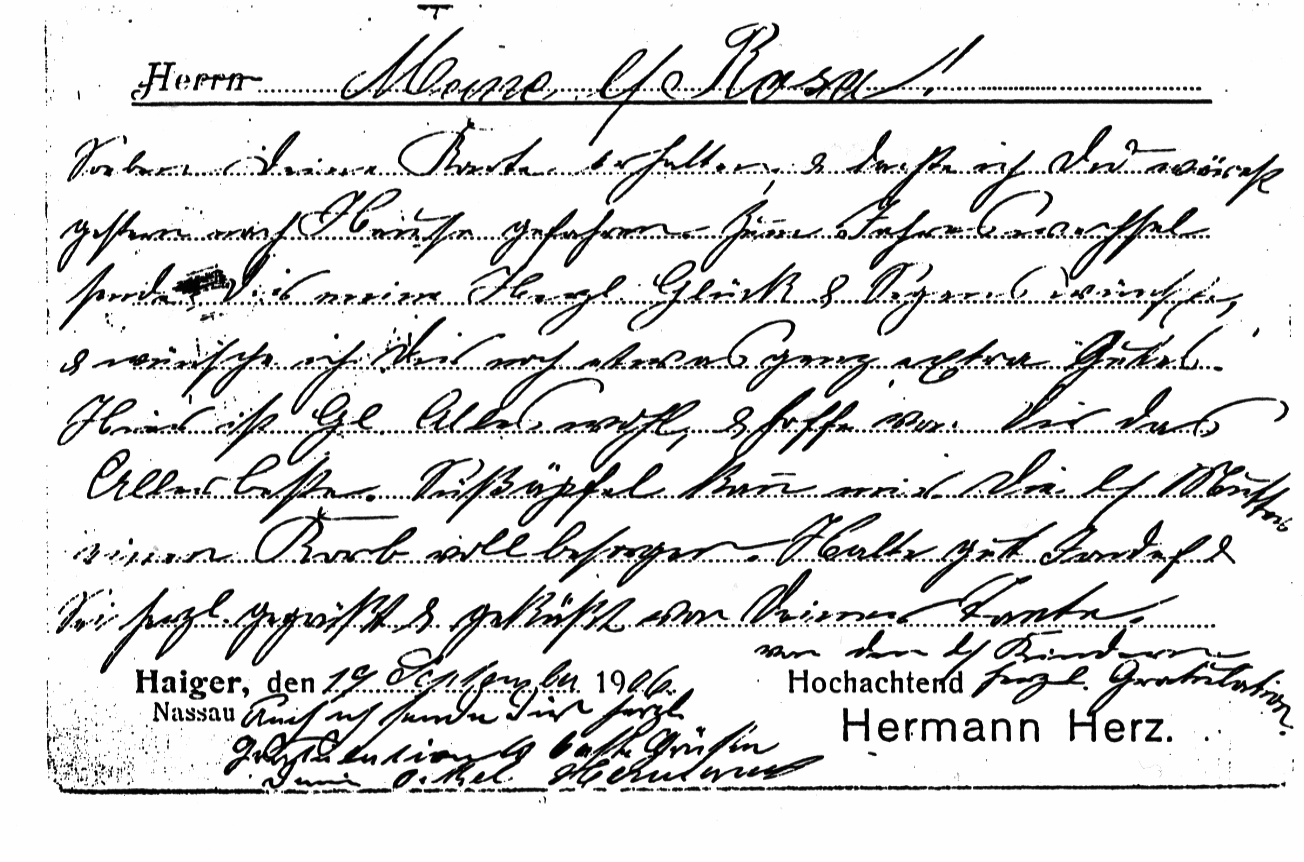 on a 1906 postcard to Rosa Sommer (1881-1959), the daughter of Franziska's sister Sarah Katzenstein. Herman
Herz's handwriting is on the bottom left, starting just after the word "Nassau" (this area was part of the
Province of Hesse-Nassau until 1918).
on a 1906 postcard to Rosa Sommer (1881-1959), the daughter of Franziska's sister Sarah Katzenstein. Herman
Herz's handwriting is on the bottom left, starting just after the word "Nassau" (this area was part of the
Province of Hesse-Nassau until 1918).
We also have a picture, dated August 5, 1937, of Franziska Katzenstein and Hermann Herz (the fourth and fifth people from the left among the standing group) as part of a group picture of the last Jews of Haiger . From the same photography session we have a picture of Herman Herz and "Inge", together with his dated handwriting. Hermann Herz passed away about six months later.
At some point in time after June 22 1939 (the date at the top of page 1) and only weeks before the outbreak of hostilities, Coralie Weill traveled to Haiger to bring Franziska Katzenstein to France. Here are the German documents that she had to fill out and sign using her new, Nazi-imposed, name of Franziska Sara Herz.
Thanks to research of Horst Hecker, the archivist in Frankenberg and the author of Jüdisches Leben in Frankenberg we can follow the wanderings of Franziska Katzenstein during the war.
According to the documents used by Hecker, Franziska Katzenstein went to Dijon in 1940 after the German invasion. This seems strange as not only was Dijon in the occupied zone, but it was much closer to the German border than the south or west of France. In any case she was still in Dijon in April 1941, when she obtained an official French translation of her birth certificate. Albert Herz was living in Limoges on this date, so perhaps this document is related to plans to rejoin her son.
Here are some photographs related to Franziska Katzenstein and Herman Herz.
-
Amalie Marx and Abraham Katzenstein were married in Frankenau on May 20, 1851. Here is the left side
 of the marriage registration.
Notice that Amalie Marx is referred to as
"Malchen" (the diminutive of "queen" in Judeo-German). She referred to in the same way on the birth
registration of Franziska Katzenstein (above).
of the marriage registration.
Notice that Amalie Marx is referred to as
"Malchen" (the diminutive of "queen" in Judeo-German). She referred to in the same way on the birth
registration of Franziska Katzenstein (above).
Here is the right side
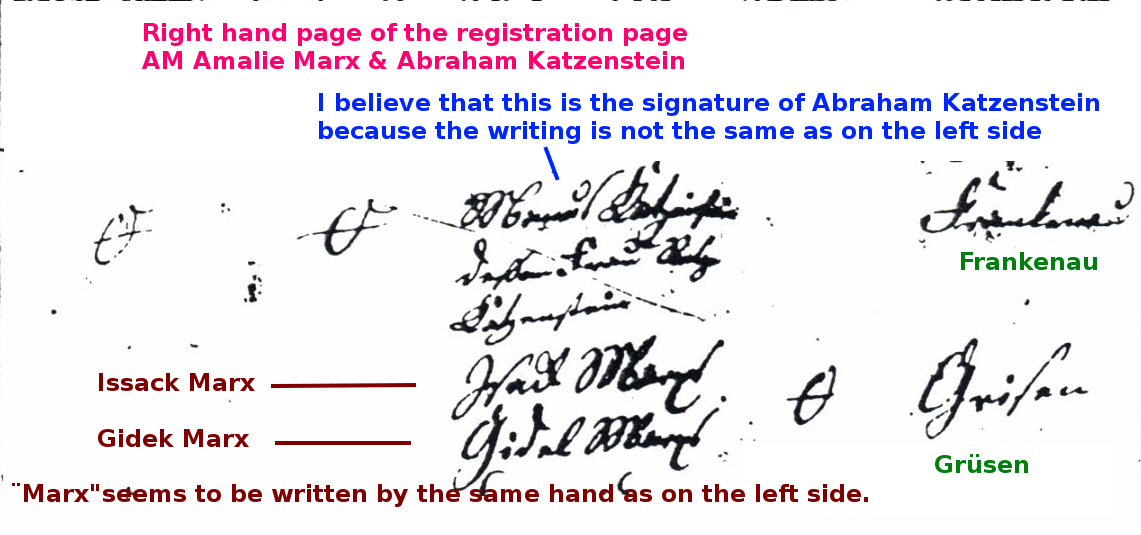 of the marriage registration. As indicated this may be Abraham Katzenstein's
signature.
of the marriage registration. As indicated this may be Abraham Katzenstein's
signature.
We are fortunate (thanks to Meta Miller) in having a photograph
 of the family taken in late 1873 or early 1874. The baby on Amelia Marx's lap is Franziska
Katzenstein. Two of the older children are not in the picture.
of the family taken in late 1873 or early 1874. The baby on Amelia Marx's lap is Franziska
Katzenstein. Two of the older children are not in the picture.
In October, 2010 we visited the beautifully restored half-timbered house
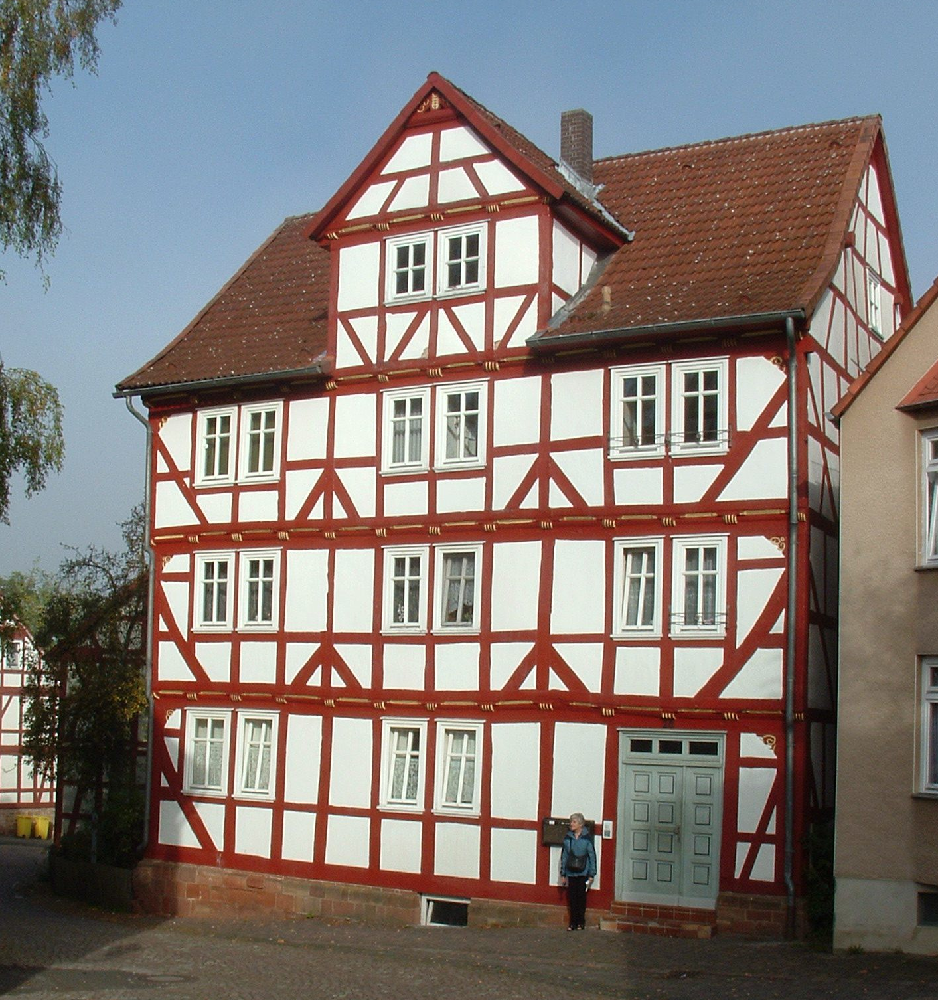 in which Amalie Marx and Abraham Katzenstein and
their children lived in Frankenberg. The store was just to the right of the
house, but it has now been incorporated into an apartment building.
in which Amalie Marx and Abraham Katzenstein and
their children lived in Frankenberg. The store was just to the right of the
house, but it has now been incorporated into an apartment building.
Here are the pages on Abraham Katzenstein, with a list of the children from the book Jüdisches Leben in Frankenberg by Horst Hecker, the archivist in Frankenberg.
Here are the pages on Abraham Katzenstein from a genealogy of the Jews of Frankenberg by Karl-Heinz Stadler.
Here are some photographs related to Amalie Marx and Abraham Katzenstein.
-
Unfortunately the only document that we have that mentions this couple is the 1900
marriage certificate of Franziska Katzenstein and Hermann Herz. The couple is not mentionned as being
decreased (as is the case with Abraham Katzenstein) so we know that Regine Fröhlich was still alive.
Albert
Herz could only recall that Jacob Herz passed away sometime
during World War I.
From the marriage certificate we know that Hermann Herz was born in Altenkirche, Kreis Wetzlar. The present day town of Wetzlar is about 40 km southeast of Haiger, but there seem to have been two villages with the name Altenkirche. Despite our efforts and that of various town officials we were unable to obtain furthe information.